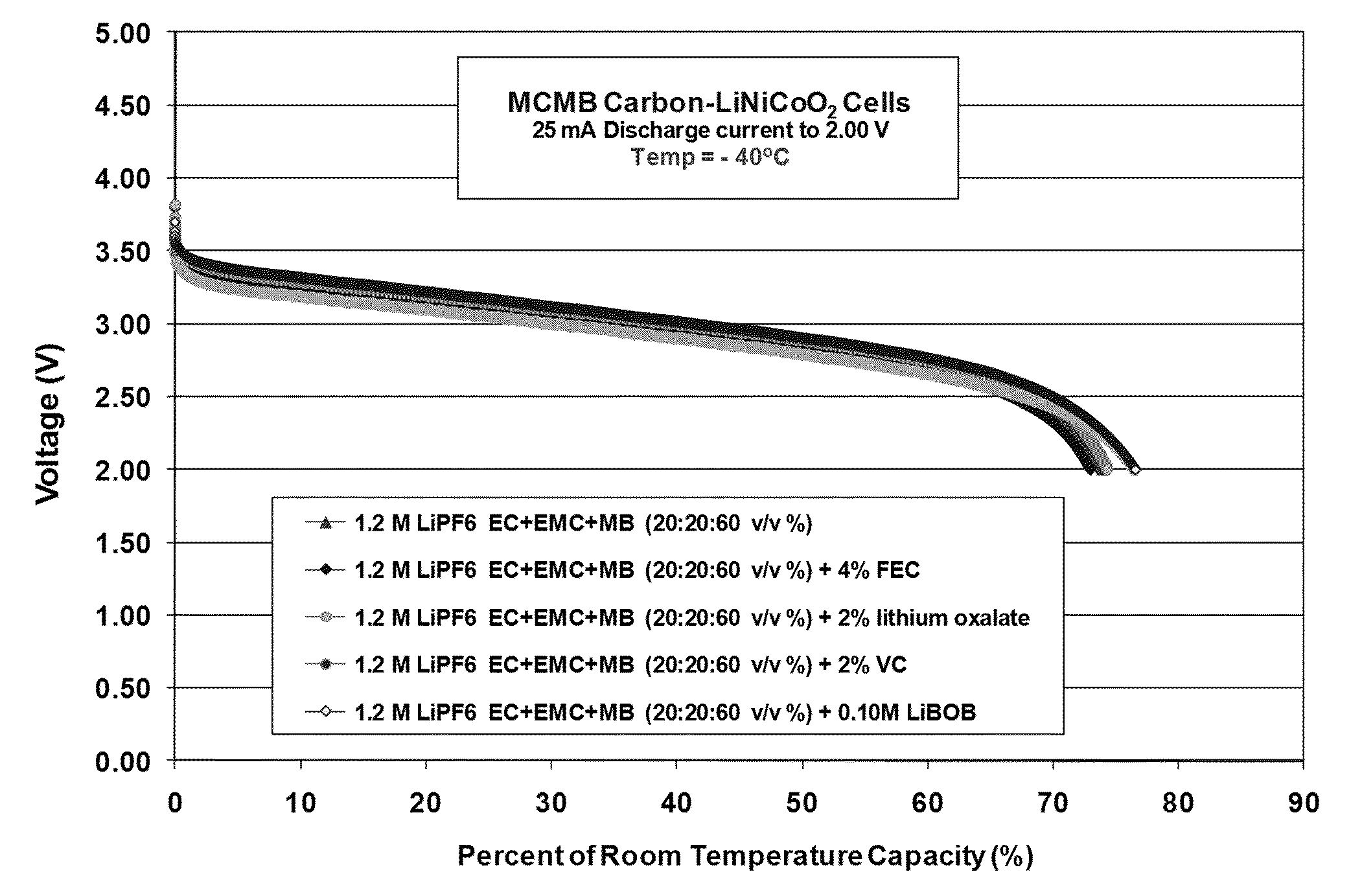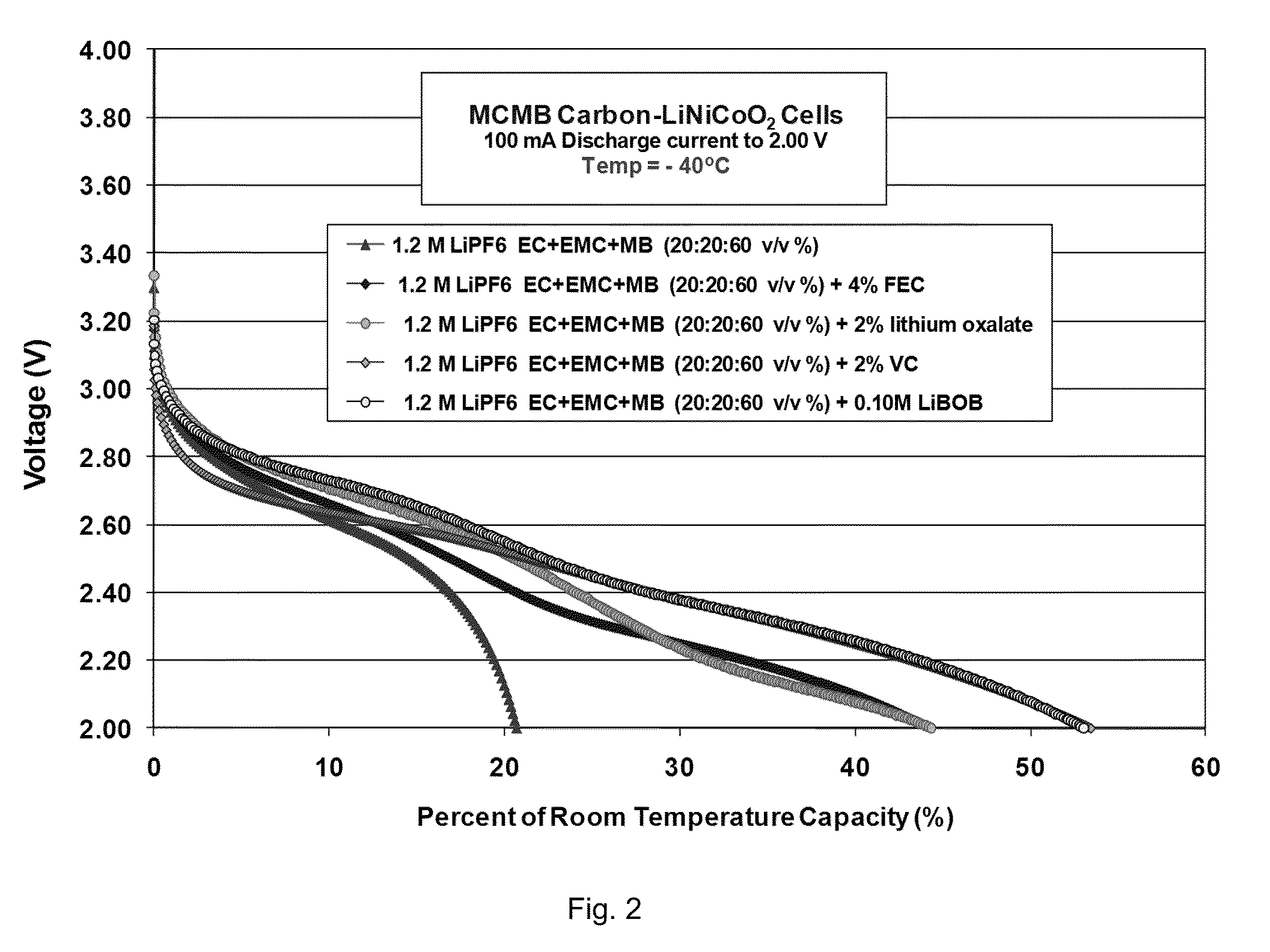Electrolytes for wide operating temperature lithium-ion cells
a lithium-ion cell, wide-ranging technology, applied in secondary cell details, sustainable manufacturing/processing, batteries, etc., can solve the problems of limited life, poor abuse tolerance, narrow operating temperature range, etc., to achieve good discharge stability, large cycle life, and use of performance attributes
- Summary
- Abstract
- Description
- Claims
- Application Information
AI Technical Summary
Benefits of technology
Problems solved by technology
Method used
Image
Examples
example 1
Methyl Butyrate-Based Electrolyte Solutions Containing Additives MCMB-LiNiCoO2 cells
[0101]In the current study, we demonstrated improved performance of Li-ion cells with methyl butyrate-based electrolytes, including:
1) 1.0 M LiPF6 EC+EMC+MB (20:20:60 v / v %)
2) 1.0 M LiPF6 EC+EMC+MB (20:20:60 v / v %)+2% FEC
3) 1.0 M LiPF6 EC+EMC+MB (20:20:60 v / v %)+4% FEC
[0102]4) 1.4 M LiPF6 EC+EMC+MB (20:20:60 v / v %)+lithium oxalate
5) 1.0 M LiPF6 EC+EMC+MB (20:20:60 v / v %)+2% VC
6) 1.0 M LiPF6 EC+EMC+MB (20:20:60 v / v %)+0.10M LiBOB
[0103]Lithium-ion cells, comprising MCMB carbon anodes and LiNi0.8Co0.2O2 cathodes, were utilized to study the electrolytes. These cells served to verify and demonstrate the reversibility, low temperature performance, and electrochemical aspects of each electrode as determined from a number of electrochemical characterization techniques.
Formation Characteristics
[0104]As illustrated in Table 5, good performance characteristics of the cells containing the methyl butyrate-based e...
example 2
Methyl Propionate-Based Electrolyte Solutions Containing Additives
[0124]In the current study, we demonstrated improved performance of Li-ion cells with methyl propionate-based electrolytes, including:
[0125]1) 1.0 M LiPF6 EC+EMC+MP (20:20:60 v / v %)
[0126]2) 1.0 M LiPF6 EC+EMC+MP (20:20:60 v / v %)+2% FEC
[0127]3) 1.4 M LiPF6 EC+EMC+MP (20:20:60 v / v %)+lithium oxalate
[0128]4) 1.0 M LiPF6 EC+EMC+MP (20:20:60 v / v %)+2% VC
[0129]5) 1.0 M LiPF6 EC+EMC+MP (20:20:60 v / v %)+0.10M LiBOB
[0130]Lithium-ion cells, comprising MCMB carbon anodes and LiNiCoAlO2 cathodes, were utilized to study the electrolytes (electrodes supplied by Quallion, LCC). These cells served to verify and demonstrate the reversibility, low temperature performance, and electrochemical aspects of each electrode as determined from a number of electrochemical characterization techniques.
Formation Characteristics
[0131]As illustrated in Table 9, good performance characteristics of the cells containing methyl propionate-based electrol...
example 3
Methyl Propionate-Based and Ethyl Butyrate-Based Electrolyte Solutions Without Additives
[0141]In the current study, the electrolyte was selected to have a salt concentration of 1.20M and an ester content of 60% by volume. More specifically, the electrolytes 1.20M LiPF6 in EC+EMC+MP (20:20:60 v / v %) and 1.20M LiPF6 in EC+EMC+EB (20:20:60 v / v %) were demonstrated to operate effectively over a wide temperature range in MCMB-LiNiCoAlO2 and Li4Ti5O12—LiNiCoAlO2 prototype cells. These electrolytes were compared with low temperature electrolytes developed in-house by Quallion, LCC, referred to as “A1”, “A2”, “A3”, and a baseline all-carbonate based electrolyte adopted by DOE for their automotive battery development programs. Thus, the following electrolytes were evaluated in biomedical / aerospace-quality 0.25Ah lithium-ion cells, manufactured by Quallion, LLC, consisting of carbon (or Li4Ti5O12) anodes and LiNiCoAlO2(NCA) cathodes:
[0142]1) 1.2 M LiPF6 in EC+EMC (30:70 v / v %) (DoE, Baseline)...
PUM
| Property | Measurement | Unit |
|---|---|---|
| standard cell voltage | aaaaa | aaaaa |
| temperatures | aaaaa | aaaaa |
| temperature | aaaaa | aaaaa |
Abstract
Description
Claims
Application Information
 Login to View More
Login to View More - R&D
- Intellectual Property
- Life Sciences
- Materials
- Tech Scout
- Unparalleled Data Quality
- Higher Quality Content
- 60% Fewer Hallucinations
Browse by: Latest US Patents, China's latest patents, Technical Efficacy Thesaurus, Application Domain, Technology Topic, Popular Technical Reports.
© 2025 PatSnap. All rights reserved.Legal|Privacy policy|Modern Slavery Act Transparency Statement|Sitemap|About US| Contact US: help@patsnap.com



